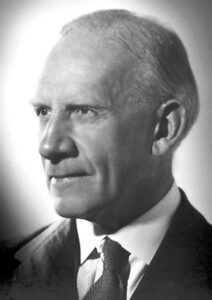Sir Robert Robinson

Sir Robert Robinson (1886-1975) was an organic chemist (organic chemistry being the study of carbon-containing compounds). Throughout his career, Robinson made a wide variety of discoveries, including those that led to the development of the first synthetic antimalarial drug, which can be used to treat or prevent malaria. Whilst at St Andrews, Robinson invented the ring symbol for benzene, which is still in use today.
Early Life
Sir Robert Robinson was born in 1886, at Rufford, near Chesterfield, Derbyshire.
He went on to study chemistry at the University of Manchester, where he graduated in 1905 with a Bachelor of Science, and in 1910 with a Doctor in Science. Following this, he continued his research at the university due to being awarded an 1851 Research Fellowship from the Royal Commission for the Exhibition of 1851.
Career
In 1921, after spending time at a range of universities, including the University of Sydney and the University of Liverpool, Robinson became a professor at the University of St Andrews. Whilst he only worked at the university for two years, he made a number of key discoveries and inventions.
In one paper, co-authored with William Kermack, and published in 1922, was the first illustration of the technique known as election, or arrow, pushing. This is a way to show the progression of reactions within organic chemistry, however, in recent years, the technique has been expanded to a range of other areas, such as in inorganic chemistry (the study of substances that contain little or no carbon). Whilst this illustration was of low importance when the paper was first published, the simplicity of the arrow symbol led to a rapid increase in its use globally.

Another one of Robinson’s inventions was the symbol for benzene, a toxic, colourless, liquid with a distinctive sweet odour. Throughout the 1920s, benzene was seen as a vital compound due to its properties and its uses, however, scientists could not agree on the best way to represent it. It was in 1923, when Robinson and his research student, James Armit, published the first paper to suggest that a hexagon with a circle in the centre would be the best way to represent benzene, which has gone on to be accepted worldwide.
Following Robinson’s time at St Andrews, he continued to make a range of other discoveries. One of which was his discovery of the molecular structures (the 3D configuration of a molecule) of morphine and penicillin (morphine being a medication used for pain relief and penicillin being an antibiotic that is used to treat bacterial infections). These innovations subsequently led to the development of a range of antimalarial drugs.
From 1945 to 1950, Robert Robinson was elected to become the president of The Royal Society, which is the UK’s national academy of sciences. It aims to promote science, recognise, and support excellence within science, and provide advice for science education, policy, and public engagement. As president, Robinson would have had the task of chairing the society’s council, which is what governs the society.
Awards
Due to Robinson’s impact on the development of organic chemistry, he was honoured with a variety of awards including the Royal Medal in 1932 from The Royal Society, the Flintoff Medal in 1960 from the Royal Society of Chemistry, and in 1947, he was awarded the Medal of Freedom from the US Government. In the same year, Robinson’s work on plant products that are of biological importance led him to receive the Nobel prize for Chemistry.
